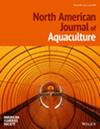Fine‐solids removal by foam fractionation in a low‐salinity marine recirculating aquaculture system (RAS)
IF 1.3
4区 农林科学
Q3 FISHERIES
引用次数: 0
Abstract
ObjectiveWe sought to evaluate several methods of operation of a foam fractionator for fine‐solids removal (organic matter < 55 μm) in a commercial‐scale, low‐salinity (11–13‰) recirculating aquaculture system (RAS) for marine finfish production.MethodsThe total suspended solids (TSS) concentrations of the RAS microscreen drum filter inflow and outflow and the foam fractionator outflow were obtained under various foam fractionator operating conditions. The outflow TSS concentration of the drum filter also served as the inflow TSS concentration for the foam fractionator. Sample collection for TSS determination was divided into two categories: particles greater than 55 μm and particles less than 55 μm. The difference between inflow and outflow TSS concentrations was used to determine the removal percentage for each particle class of each unit. Additionally, the volume of foammate produced under operating conditions by the fractionator and the amount of solids contained within the foammate were quantified. Flow through the foam fractionator was also obtained to determine the amount of solids removed per volume of influent water treated.ResultThe influent TSS concentration for the seven different operating conditions evaluated ranged from 4.8 to 6.3 mg/L, with the percentage of particles less than 55 μm ranging from 69.75% to as high as 86.1%. The drum filter removed over 90% of the particles larger than 55 μm and removed 8–26% of the particles smaller than 55 μm. No difference was observed in the overall removal efficiency of the drum filter, which ranged from 19% to 44%. There was no significant difference in the foam fractionator overall removal efficiency, which ranged from 6.5% to 38.5%. Operating the foam fractionator at a high water head height (HHH) with the submersible aspirating impeller provided the greatest removal percentage of particles less than 55 μm (26.9%). However, at the HHH, only half the amount of solids was removed compared to using a Venturi injector with ozone, but energy use was roughly 26% greater.ConclusionThe foam fractionator was operated at the HHH, about 0.31 m higher than the low water head height, for production operation. Additionally, Venturi injection of ozone provided the greatest removal of solids for the volume of influent water treated over a 12‐h operational period. The submersible aspirating impeller showed potential for low‐cost use with reasonable solids removal and warrants further evaluation.在低盐度海水循环养殖系统(RAS)中通过泡沫分馏去除细固体
方法在不同的泡沫分馏器操作条件下,获得 RAS 微筛鼓式过滤器流入和流出以及泡沫分馏器流出的总悬浮固体(TSS)浓度。鼓式过滤器流出的总悬浮固体浓度同时也是泡沫分馏器流入的总悬浮固体浓度。用于测定 TSS 的样品收集分为两类:大于 55 μm 的颗粒和小于 55 μm 的颗粒。流入和流出的 TSS 浓度之差被用来确定每个单元中每类颗粒的去除率。此外,还对分馏器在运行条件下产生的泡沫量和泡沫中含有的固体量进行了量化。还获得了通过泡沫分馏器的流量,以确定每处理一定量的进水所去除的固体量。结果在所评估的七种不同运行条件下,进水的 TSS 浓度在 4.8 至 6.3 毫克/升之间,小于 55 μm 的颗粒百分比从 69.75% 到高达 86.1%。鼓式过滤器可去除 90% 以上大于 55 μm 的颗粒,去除 8-26% 小于 55 μm 的颗粒。鼓式过滤器的总体去除效率在 19% 到 44% 之间,没有发现差异。泡沫分馏器的总体去除效率从 6.5% 到 38.5% 不等,没有明显差异。在高水头高度(HHH)下运行泡沫分馏器并使用潜水吸入式叶轮,可最大程度地去除小于 55 μm 的颗粒(26.9%)。然而,与使用文丘里喷射器喷射臭氧相比,在高水头高度下仅能去除一半的固体,但能耗却高出约 26%。此外,在 12 小时的运行期间,文丘里喷射臭氧对进水处理量的固体去除率最高。潜水吸入式叶轮显示出低成本使用的潜力,同时具有合理的固体去除率,值得进一步评估。
本文章由计算机程序翻译,如有差异,请以英文原文为准。
求助全文
约1分钟内获得全文
求助全文
来源期刊
CiteScore
2.50
自引率
0.00%
发文量
46
审稿时长
18-36 weeks
期刊介绍:
The North American Journal of Aquaculture publishes papers on new research and practical experience in all areas of intensive and extensive fish culture. Topics include broodstock selection and spawning, nutrition and feeding, health and water quality, facilities and production technology, and the management of ponds, pens, and raceways.
The journal will consider papers dealing with ways to improve the husbandry of any aquatic species—marine or freshwater, vertebrate or invertebrate—raised for commercial, scientific, recreational, enhancement, or restoration purposes that may be of interest to practitioners in North America. Its scope includes both basic and applied science, but applied scientific endeavors—including practical experiences, descriptive studies, and other nontraditional, but pertinent works—are emphasized.

 求助内容:
求助内容: 应助结果提醒方式:
应助结果提醒方式:


